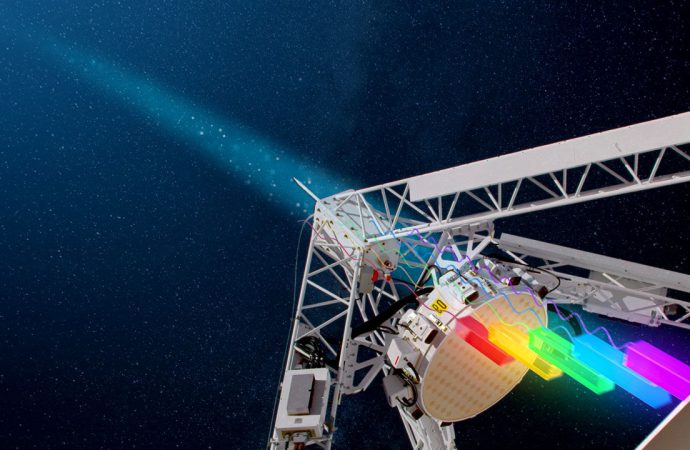Roughly half of the “normal” matter in the universe—the stuff that makes up stars, planets, and even us—exists as mere wisps of material floating in intergalactic space, according to cosmologists. But astronomers had no good way to confirm that, until now.
Source: Science Magazine
A new study has used fast radio bursts (FRBs)—powerful millisecondslong pulses of radio waves coming from distant galaxies—to weigh intergalactic matter, and the results match up with predictions.
“Using FRBs as a probe has been an exciting prospect for a while,” says astronomer Paul Scholz of the University of Toronto, who was not involved with the work. “Now that we’ve built up a sample of local FRBs, we’re starting to be able to do this. It’s certainly exciting.”
Over the past few decades, cosmologists have compiled an inventory of the stuff that makes up the universe. Some 68% is dark energy, a mysterious force accelerating the universe’s expansion. Another 27% is clumps of dark matter that hold galaxies together. Just 5% is so-called normal matter.
Cosmologists know how much normal matter there should be; they can calculate it from how much the big bang should have produced and from the microwave ripple of this cosmic event that still echoes through space. But they can only see about half of it glowing as galaxies and dense gas clouds. The rest, a rarified, intergalactic gas of just one or two atoms in the volume of a typical office room, has been almost impossible to detect.
That was until the first FRB burst on the scene in 2007. Because these sporadic blasts are so bright and short, FRBs were originally thought to come from an instrumental glitch, or a source on Earth. (Some early “FRBs” were found to come from a microwave oven at an observatory.) But as detections of FRBs piled up, astronomers realized they were coming from distant corners of the universe. Pinpointing them was difficult because of their rarity: Observers had to be pointing in the exact right direction to catch one, and they wouldn’t have time to focus other scopes on the source. These days, telescopes that view large portions of the sky continuously are bagging more FRBs.
FRBs revealed their distant origins through a phenomenon known as dispersion. An FRB pulse begins as a range of bunched-up frequencies, but as it travels, “it feels every electron along its path,” says astronomer Sarah Burke-Spolaor of West Virginia University, who was not involved with the work. Low frequencies experience more drag from electrons than high ones, so when the pulse reaches a radio telescope on Earth, low frequencies lag behind. The amount of lag tells astronomers how many electrons the pulse has traveled through, which can be correlated to the total amount of matter.
The technique can reveal the density of matter across the cosmos, but only if the distance to the FRB’s source is known. Up until recently, only a handful of FRB sources have been pinpointed—either because they happened to be one of the rare, repeating FRBs, or because they were spotted with a telescope array that could focus multiple instruments on the source galaxy. Today in Nature, a team of astronomers report the discovery of four new FRBs with known source galaxies, identified with the Australian Square Kilometre Array Pathfinder (ASKAP), an array of 36 radio dishes in Western Australia.
Using those and one of the previously pinpointed FRBs, scientists calculated the density of normal matter across a large swath of the local universe. The researchers found that, if extrapolated across the universe, there was enough normal matter to account for the half that was missing, in line with theoretical predictions.
“To see how well the FRB experiment is working with even a small sample was both surprising and gratifying,” says team member Xavier Prochaska of the University of California’s Lick Observatory. “It checks off this fundamental aspect of cosmology. Crisis averted!”
The FRB technique could also be used to map variations in matter density across the universe. That could help theorists understand how matter clumps together into the “cosmic web,” the network of galaxy clusters strung across the universe. So far, astronomers can see the glowing galaxies that make up the web, but not the gas between them. The ASKAP researchers hope to build up a collection of about 100 FRBs with known sources over the next year, so they will know not just that the normal matter is there, but exactly where it is hiding.
Source: Science Magazine

































Leave a Comment
You must be logged in to post a comment.